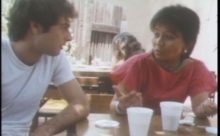Excerpt from Randolph Lewis' book "Navajo Talking Picture: Cinema on Native Ground
“Could you ask her why she thinks I’m using her?” In a darkened room in a dusty hogan on the Navajo reservation in northern Arizona, Arlene Bowman, a young Navajo filmmaker, is working with an inexperienced translator to make her grandmother understand the question. More than language divides the two women on this day in the early 1980s. Young and urbane, Bowman is one of the first Native women in the Film Studies graduate program at UCLA. Her grandmother, Ann Ruth Biah, is a traditional woman accustomed to life without electricity and other conveniences, and she does not want a camera crew hounding her while she prepares dinner.
Taking turns in the shadows of the poorly lit kitchen, the two women seem to look past one another until finally, after the translation process lumbers forward and shades of meaning seem to disappear between the generations, the grandmother answers her persistent granddaughter. “I don’t like it,” she blurts out in Navajo, referring to the film production with a bitterness that transcends linguistic difference. She describes the cultural prohibitions against such “picture taking” among older Navajos such as herself and then turns to the translator, not her granddaughter, and says, “I don’t know why she keeps bothering me with this.” Not even ten minutes into the film, the audience might be inclined to ask the same question.
Almost thirty years after she first pointed a camera at her traditional Navajo grandmother, Arlene Bowman’s Navajo Talking Picture remains a provocative and unsettling work of nonfiction cinema. Even today, tempers flare when film festival audiences have a chance to watch Bowman’s relentless pursuit of her grandmother. The filmmaker is well aware that audiences have a passionate response to the film: "Camps are set up,” she says. “Some people become hostile and shout at one another. But I've been told that when a movie creates a lot of emotion, it is a sign of a good film.” Some reviewers commented on the positive qualities of the film when it was released in 1986. The Los Angeles Times praised it as “unsparingly honest,” while the anthropologist Deirdre Evans-Pritchard noted that, "The interaction between the two women [Bowman and her grandmother] is electrifying, creating a dramatic tension rare in a documentary.”
Other responses were more ambivalent, including an LA Weekly reviewer who wrote, “Bowman herself emerges as a sympathetic character from an absurdist comedy as both her ancestry and film goals elude her.” The strongest emotions came from the dissenting camp, which expressed itself with tough words even in academic contexts where more subdued responses are the norm. Writing in the prestigious journal American Ethnologist in 2003, anthropologist Les Field seemed to speak for the film’s detractors when he claimed that it represented “less a simple failure than a painful extended disaster.”
Honest? Absurd? Disastrous? Viewers should decide for themselves. I see the film as a perplexing work with continuing relevance---and one that has not received the critical attention it deserves. It invites hard questions about documentary ethics, visual anthropology, post-colonial theory, avant-garde “family portrait” cinema, and past representations of Navajo people. It’s a fascinating documentary for anyone interested in Native American Studies or film studies.
--- Randolph Lewis
Adapted excerpt from Randolph Lewis', Navajo Talking Picture: Cinema on Native Ground. University of Nebraska Press, 2012. Adapted by the author.”
